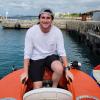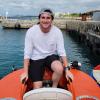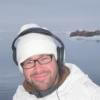Fishing has always involved ingenuity and invention, from the Pacific Islanders’ ancient tailoring of bones and shells into fish hooks (long before metal arrived in their cultures) to modern uses of everything from rotational sensors to machine learning to digitally understand where, when and how fishing takes place. Innovation typically takes place “in-house”, i.e. led by the fishing industry itself, with an increasing movement of start-ups, NGOs and entrepreneurs – motivated primarily by tackling the environmental and social challenges of seafood production – now joining this challenge. We have created a new “Sustainable Fishing Challenges” group on WILDLABS to try foster more of this innovation and collaboratively make fishing fit for the future.
At a very basic level, the three essential elements of fishing are 1. The vessel, 2. The fishing equipment (or “gear”), and 3. The fish (obviously). While some commonplace technologies are unrecognisable from those of the past (i.e. sonar fish finders, digital catch logbooks), some of the crucial components of the job have altered little (i.e. net design). Newly proposed vessel, gear or fish catch monitoring technologies must be robust, efficient and durable, meaning innovation needs to be answering a genuine need and be subject to thorough, collaborative testing (and consensus-building) before new advances are adopted across whole fleets or countries.
In this group, we challenge users to contribute their insights/expertise/opportunities across each of these three areas.
Learn more about these challenge areas:
No showcases have been added to this group yet.
WILDLABS & Wildlife Conservation Society (WCS)
I'm the Bioacoustics Research Analyst at WILDLABS. I'm a marine biologist with particular interest in the acoustics behavior of cetaceans. I'm also a backend web developer, hoping to use technology to improve wildlife conservation efforts.





- 41 Resources
- 38 Discussions
- 33 Groups
- @lawaii
- | he/him
Hi, I’m Lawaii, Mother Earth’s son. A biodiversity activist and conservation strategist walking alongside the small islands of the Sundaland Bio-ecoregion Hotspot
- 0 Resources
- 0 Discussions
- 5 Groups
- @RALR
- | She/Her
CatchCam Technologies
Science Communication | Languages: Portuguese (Brazil), English, Italian and Spanish



- 0 Resources
- 2 Discussions
- 6 Groups
- @carlybatist
- | she/her
ecoacoustics, biodiversity monitoring, nature tech



- 113 Resources
- 361 Discussions
- 19 Groups
- @aranFish
- | He/Him
CatchCam Technologies
Former CTO at SafetyNet Technologies


- 1 Resources
- 1 Discussions
- 6 Groups
- @nazarioe11
- | She/Her
University of California Santa Cruz
Graduate student interested in marine predator physiology, biogeography, and conservation.
- 0 Resources
- 0 Discussions
- 4 Groups
- @Freaklabs
- | He/Him
Freaklabs
I'm an engineer and product designer working in conservation technology. I specialize in technology for landscape restoration and wildlife behavioral ecology.



- 1 Resources
- 307 Discussions
- 20 Groups
Worked as a mechanical engineer for a defence co, then software engineer, then for a research lab specialising in underwater robotics.



- 1 Resources
- 144 Discussions
- 16 Groups
WildAid
Surveillance and enforcement of marine protected areas.
- 0 Resources
- 2 Discussions
- 5 Groups
- @KellyFaller
- | she/her/hers
Rutgers University
Lead Estuary Science Coordinator at the Partnership for the Delaware Estuary and Masters Student at Rutgers University in the Department of Ecology and Evolution. Using bioacoustics in tidal marsh ecosystems for restoration and conservation.

- 0 Resources
- 4 Discussions
- 14 Groups
- @serena.le
- | she/her
Conservation tech enthusiast
- 0 Resources
- 0 Discussions
- 24 Groups
- 0 Resources
- 0 Discussions
- 22 Groups
Funding
The aquaculture industry is a vital producer in the global fish market— it accounts for nearly half of the fish we eat. However, many of the industry’s practices are environmentally and economically unsustainable. With...
28 February 2016
We are living in the midst of a pretty exciting era. Never before has humanity been more educated, more connected, more enabled, or more empowered than we are today. There are many reasons to be optimistic about the...
17 February 2016
New horizon scanning report published this month identifies 15 emerging threats and opportunities for global biodiversity.
3 February 2016
Are you a scientist in an ASEAN country? Are you interested in applying your skills beyond the lab or the classroom? Apply now for the ASEAN-U.S. Science and Technology Fellows Program for an opportunity to join a team...
26 January 2016
Gary Atkinson, Director of Emerging Technologies at ARM, explains why we should be interested in the Internet of Things. Could it be a game changer for conservation?
10 December 2015
Article
Traceability (knowing where products come from and how they are made) is a foundational pre-cursor for many sustainability interventions. While many tools have been developed to offer high-level insight about the...
26 November 2015
September 2024
November 2023
event
17 Products
0 R&D Projects
13 Organisations
Recently updated products
Recently updated organisations
| Description | Activity | Replies | Groups | Updated |
|---|---|---|---|---|
| Thanks for sharing this Rosita! I've just sent you an email about coming on Variety Hour to talk about CatchCam :) |
|
Sustainable Fishing Challenges | 1 week 1 day ago | |
| I was looking into the available products and discussions but couldn't seem to find groups working on fish otoliths as a target for... |
|
Sustainable Fishing Challenges | 1 week 5 days ago | |
| I create ocean exploration and marine life content on YouTube, whether it be recording nautilus on BRUVs, swimming with endangered bowmouth... |
|
Acoustics, AI for Conservation, Animal Movement, Camera Traps, Citizen Science, Drones, Emerging Tech, Marine Conservation, Sensors, Sustainable Fishing Challenges, Wildlife Crime | 1 month 2 weeks ago | |
| Hey Xavier! Thank you for your interest and question!! The overarching goal of the FinDrop v1 for the WildLabs award is to characterize an instrument and make it as, if... |
|
Acoustics, Build Your Own Data Logger Community, Marine Conservation, Protected Area Management Tools, Sustainable Fishing Challenges | 11 months 2 weeks ago | |
| Hi Sol,If the maximum depth is 30m, it would be worth experimenting with HydroMoth in this application especially if the deployment time is short. As Matt says, the air-filed case... |
|
Acoustics, AI for Conservation, Data management and processing tools, Emerging Tech, Sustainable Fishing Challenges | 1 year 3 months ago | |
| Hi Scott, thanks so much for sharing your thoughts here! It would be great to learn more about this, would you be interested in finding a time to chat? Thanks! |
|
Marine Conservation, Sustainable Fishing Challenges, Wildlife Crime | 1 year 5 months ago | |
| If you are considering an external microphone and a towed system, then you would also be in a position to consider a raspberry pi with an external microphone with sbts-aru.... |
|
Acoustics, AI for Conservation, Marine Conservation, Sustainable Fishing Challenges | 1 year 7 months ago | |
| Hey Evelyn, I work on building self-powered buoys that collect various sensor data (sea surface and sub-surface) that can be sent back to mainland over cellular/satellite... |
+4
|
Sustainable Fishing Challenges | 3 years 2 months ago | |
| I’m an editor at FoodUnfolded – an EU-funded platform focused on reconnecting people with their food and where it comes from,... |
|
Sustainable Fishing Challenges | 4 years 2 months ago | |
| Hi all, Just some things I've come across on Twitter or through Wildlabs that weren't in a thread yet, for everyone's... |
|
Sustainable Fishing Challenges | 4 years 4 months ago | |
| Hi all! I am not in the marine/aquatic space myself, but I stumbled across this resource and wanted to share with you. It's a list... |
|
Sustainable Fishing Challenges | 4 years 4 months ago | |
| Hi Karima - Are you looking for volunteers in specific regions or fisheries? |
|
Sustainable Fishing Challenges | 4 years 5 months ago |
What if we could see what fishing gear is doing underwater?
29 July 2025 3:53pm
Any emerging techs here working on fish otolith morphometry and counting?
1 August 2025 3:53pm
MS and PhD Opportunities in Ocean Engineering and Oceanography (Fall 2026)
24 July 2025 5:55am
I WANT TO TELL YOUR STORY
29 June 2025 10:22am
MS and PhD Opportunities in Ocean Engineering and Oceanography
6 October 2024 9:44am
Calling for applications for Round 3 of our Satellites for Biodiversity Award Grant
30 September 2024 5:22pm
Design-led innovation for nature
20 September 2024 2:24pm
WILDLABS AWARDS 2024 - FinDrop: Accessible Acoustic Monitoring for Mesophotic Marine Environments
5 April 2024 10:22pm
10 August 2024 6:47am
This opportunity is what got me started in deep reef fishes! The grant is for predoctoral students and is due September 30, 2024!! Happy to help or collaborate with anyone interested :)
Eligibility: STRI seeks a diversity of applicants and encourages students from institutions throughout the neotropics to apply. Awards are based upon merit, without regard to race, color, religion, sex, national origin, citizenship, age or condition of handicap of the applicant.
23 August 2024 1:58pm
Really great project @MattyD797 and team. Looking forward to seeing your progress. What is the target price of the FinDrop?
27 August 2024 5:40am
Hey Xavier!
Thank you for your interest and question!!
The overarching goal of the FinDrop v1 for the WildLabs award is to characterize an instrument and make it as, if not more, sensitive than a ST600 Ocean acoustic instrument at a fraction of the price. While I can’t at this stage provide an accurate estimate of final price, it will be a substantial price decrease over an ST600 while providing the same duration and depth expectations. That decrease in price does exponentially decrease with the number we can expect to sell/interest and may increase with additional features the beta testers suggest.
This award only gets us to the actual building of the prototype v1 by December, but we are already scheduled to have a completed product v2 built by March/April through additional collaborations that will be manufactured and sold through Sexton Underwater Housing Co.
Please let me know if you have any other questions!
CORDAP opens call for innovative projects (<$1.5M) on coral conservation and restoration
26 August 2024 6:01pm
New WILDLABS Funding & Finance group
5 June 2024 3:24pm
5 June 2024 4:14pm
6 June 2024 1:38am
6 June 2024 4:16am
Drop-deployed HydroMoth
2 April 2024 10:20am
15 April 2024 6:53am
Hi Matthew,
Thanks for your advice, this is really helpful!
I'm planning to use it in a seagrass meadow survey for a series of ~20 drops/sites to around 30 m, recording for around 10 minutes each time, in Cornwall, UK.
At this stage I reckon we won't exceed 30 m, but based on your advice, I think this sounds like not the best setup for the surveys we want to try.
We will try the Aquarian H1a, attached to the Zoom H1e unit, through a PVC case. This is what Aquarian recommended to me when I contacted them too.
Thanks for the advice, to be honest the software component is what I was most interested in when it came to the AudioMoth- is there any other open source software you would recommend for this?
Best wishes,
Sol
21 April 2024 7:10pm
Hey Sol,
No problem at all. Depending on your configuration, the Audiomoth software would have to work on a PCB with an ESP32 chip which is the unit on the audiomoth/hydromoth, so you would have to make a PCB centered around this chip. You could mimic the functionality of the audiomoth software on another chip, like on a raspberry pi with python's pyaudio library for example. The problem you would have is that the H1A requires phantom power, so it's not plug and play. I'm not too aware with the H1e, but maybe you can control the microphone through the recorder that is programmable through activations by the RPi (not that this is the most efficient MCU for this application, but it is user friendly). A simpler solution might be to just record continuously and play a sound or take notes of when your 10 min deployment starts. I think it should last you >6 hours with a set of lithium energizer batteries. You may want to think about putting a penetrator on the PVC housing for a push button or switch to start when you deploy. They make a few waterproof options.
Just somethign else that occured to me, but if you're dropping these systems, you'll want to ensure that the system isn't wobbling in the seagrass as that will probably be all you will hear on the recordings, especially if you plan to deploy shallower. For my studies in Curacao, we aim to be 5lbs negative, but this all depends on your current and surface action. You might also want to think about the time of day you're recording biodiversity in general. I may suggest recording the site for a bit (a couple days or a week) prior to your study to see what you should account for (e.g. tide flow/current/anthropogenic disturbance) and determine diel patterning of vocalizations you are aiming to collect if subsampling at 10 minutes.
Cheers,
Matt
3 May 2024 12:55pm
Hi Sol,
If the maximum depth is 30m, it would be worth experimenting with HydroMoth in this application especially if the deployment time is short. As Matt says, the air-filed case means it is not possible to accurately calibrate the signal strength due to the directionality of the response. For some applications, this doesn't matter. For others, it may.
Another option for longer/deeper deployments would be an Aquarian H2D hydrophone which will plug directly into AudioMoth Dev or AudioMoth 1.2 (with the 3.5mm jack added). You can then use any appropriately sized battery pack.
If you also connect a magnetic switch, as per the GPS board, you can stop and start recording from outside the housing with the standard firmware.
Alex
Project71: A Venture Competition for Ocean Regeneration
4 March 2024 10:49am
Species ID Needs?
19 February 2024 7:55pm
23 February 2024 2:10pm
Hello Nadia,
A forensic genetic challenge exists when DNA is destroyed by processes used in manufacturing of derivative animal products, preventing law enforcement in identification of protected species. Alternative methods such as lipid profiles or isotope analysis unique to certain species may be possible but require voucher specimens that may or may not be available and methods that have not been tested or peer reviewed. Examples below:
- derivative products made from endangered shark squalene (eg. Liver oil capsules).
- derivative products made from lion bone and tiger bone (eg. lion bone cake and tiger wine).
This is a law enforcement issue and would like to discuss possible solutions.
1 March 2024 2:27am
Hi Scott, thanks so much for sharing your thoughts here! It would be great to learn more about this, would you be interested in finding a time to chat? Thanks!
Senior Software Engineer, Skylight
21 February 2024 3:44pm
3x Ai 4 Conservation Job Roles (UK)
15 February 2024 3:28pm
Hydromoth for coastal & offshore surveying
16 November 2023 7:36am
18 November 2023 1:47am
Hi Sol,
I think your concern is well placed. The pros typically tow an array of hydrophones, in its simpler configuration it looks like a long fat rubber hose containing maybe a dozen transducers feeding their electrical signals to a recording unit back on the ship. All this is done to reduce noise from the ship, from waves crashing, and flow noise. The multiple transducers can also be electronically tuned to be directional so that it can be "pointed" away from a noise source (like the ship).
In your position, I would just try the simplest thing that could work, then fix the problems as they arise. It could be you may need to be dead in the water while recording. To address surface noise (slapping waves, wind), you could mount the hydromoth low down on a spar buoy, which you tow into position.
Best of luck, it sounds like an interesting project (c:
19 December 2023 2:20pm
Hydromoths are great for the price but they do not have the most streamlined housing and audio quality won't be as good as something like a SoundTrap or really any recorder with a proper hydrophone and 16-bit +DAQ system.
If you can afford it, this is an excellent SoundTrap based towed autonomous system NOAA have been using. It might work towed behind an autonomous vehicle
Alternatively, if you can have something inside the vehicle, a simple tape recorder (e.g. Tascam DR40X) and hydrophone on cable will provide excellent sound quality. You could also use something like a Raspberry Pi with audio focussed ADC hat to record but that would require a bit more programming. Even consider a standard AudioMoth and plug a proper hydrophone into the audio jack - this would still have a 12-bit ADC but would provide better sound quality than a hydromoth (hydrophones are more omnidirectional and there's no air filled causing reflections and attenuation)
20 December 2023 6:57am
If you are considering an external microphone and a towed system, then you would also be in a position to consider a raspberry pi with an external microphone with sbts-aru. Another option:
GitHub - hcfman/sbts-aru: Low cost Raspberry Pi sound localizing portable Autonomous Recording Unit (ARU)
Low cost Raspberry Pi sound localizing portable Autonomous Recording Unit (ARU) - hcfman/sbts-aru
Senior Spatial Ecologist
24 August 2023 11:22pm
Using an AI-based Warning System to Protect Whales in South Africa
28 July 2023 11:01am
CCI Defining Destructive Fishing Project: Update - YouTube
19 June 2023 4:26pm
The Wildlife Society Conference
19 June 2023 5:59am
Fisheries Analyst (Pacific)
15 June 2023 12:15pm
Ashored Innovations: Hardware and Software for Sustainable Fishing
1 June 2023 9:46pm
Data Visualization in Service of Coral Reefs in Micronesia
17 May 2023 8:53pm
Data Scientist (Geospatial), Global Fishing Watch
19 April 2023 10:34am
Office & Warehouse Exec
5 April 2023 6:22pm
How do I get started with mobile phones in sea turtle monitoring?
13 February 2023 10:01am
Global Fishing Watch's Marine Manager Raises the Bar on Ocean Monitoring
13 January 2023 12:09am
Crowdfunding Aerial Baseline Study of Ghost Gear in Koh Phangan, Thailand
18 December 2022 11:06am
Sea turtle monitoring
11 February 2021 11:44am
13 December 2021 6:19pm
Hi Evelyn
Not sure if you've come across this paper about green turtles in Turks and Caicos
https://www.frontiersin.org/articles/10.3389/fmars.2020.00690/full
18 March 2022 11:53pm
Hi Evelyn,
I learned of the torsooi database to collect sea turtle data. The database per se may not be that interesting as an asnwer to your question but I know they have developed software that recognizes individual sea turtles based on pictures of their heads. The pattern of the head segments allows this.
If you manage to make pictures remotely, by land-based cameras or drones or whatever, this may help monitoring the individuals.
In my humble and non-expert opinion, this software has the potential to do away with metal tags.
cheers
Frank
18 May 2022 6:03am
Hey Evelyn,
I work on building self-powered buoys that collect various sensor data (sea surface and sub-surface) that can be sent back to mainland over cellular/satellite comms. Are these nesting sites close to shore or are they relatively far out at sea?
Best,
Aadu
News: The Latest in Conservation Tech
10 March 2022 12:00am





























































5 August 2025 5:07pm
Thanks for sharing this Rosita! I've just sent you an email about coming on Variety Hour to talk about CatchCam :)